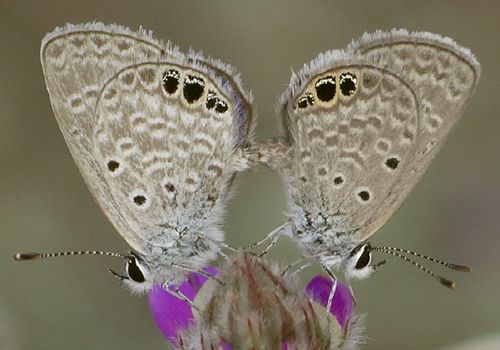by Valerie
January, 2012Ceraunus Blue
Butterflies mate back-to-back, which means it is quite difficult for them to fly away. They can escape, however, but only one does the work while the other just hangs there. Obviously, in this position, if both were to flap their wings, they would get nowhere. This is a pair of ceraunus blues (Hemiargus ceraunus), one of the smaller butterflies (wing span up to 1 inch) in our area. The name "blue" comes from the color on the upper side of the wings, which in the male is a pretty lavender-shaded sky blue. Females are also blue, but with more gray-brown towards the edges of the wings. While the typical resting position is with wings closed, the insects do sometimes sit with them open, especially on cold mornings when they want to catch the sun. The flowers on which this pair is resting are Gregg's dalea: a small, woody legume. The photo was taken at the Lady Bird Johnson Wildflower Center, where there are sizeable beds of this plant. The caterpillars of a related butterfly, Reakirt's blue, are frequently found eating the bright purple-pink blossoms, and adults of both butterflies can be found much of the year, though the ceraunus blue is less common and sometimes absent for long periods. I've never found ceraunus blue caterpillars, although they supposedly eat the same plants as Reakirt's blue larvae. Both kinds of caterpillars are tiny and slug-like, matching the woolly flower heads of their host. Reakirt's blue larvae, though, have distinctive dark marks (when closely viewed) that distinguish them from the similar ceraunus blue. |